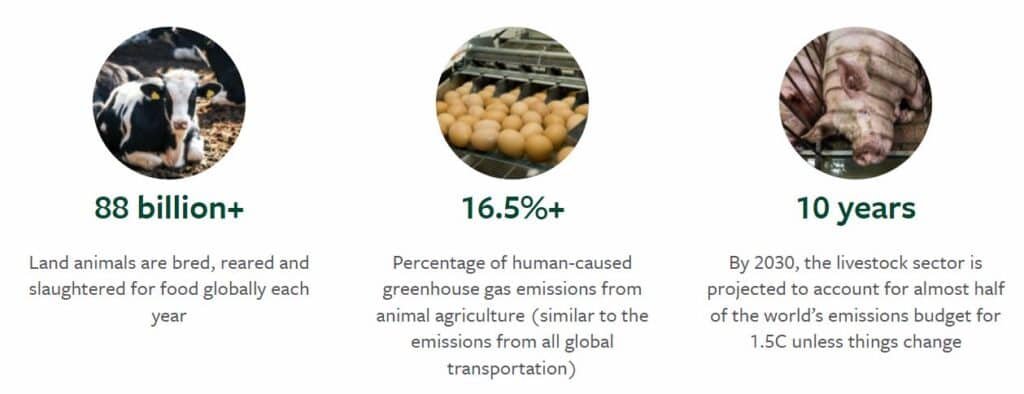Livestock emissions have become a hot topic of climate debates in recent weeks, with some countries placing restrictions on livestock farmers such as New Zealand.
Many countries are looking more closely at livestock emissions, and the industry itself is betting on its climate targets and on how to achieve them.
However, the way livestock emissions are accounted for still brings some concerns among players and stakeholders. And New Zealand seeks to levy farmers for their cows’ emissions.
Livestock Industry’s Emissions
Livestock emissions are currently not priced in the market. It means when we buy beef and other meat, their climate impacts and environmental costs are not included in their price.
Scientific reports show that animal agriculture or livestock production is responsible for at least 16.5% of global greenhouse gas (GHG) emissions. This results in negative environmental impacts such as biodiversity loss and deforestation.
- Methane, nitrous oxide (N2O) and carbon dioxide compose the industry’s total emissions.
In fact, they account for over 50% of New Zealand’s overall emissions.
Livestock supply chains emit those GHG in 4 ways:
- In the digestive process methane is produced as a byproduct
- Feed production
- manure management
- Energy consumption
Methane and nitrous oxide are from animals’ eructation (burps), flatulence (farts), urine, and manure.
These GHGs are 25x and 300x more potent than CO2 at warming the planet.
Expanding feed crops and pastures into natural areas releases CO2 which makes feed production a significant factor. Also, manure and nitrogen fertilizers emit nitrous oxide too.
Here are some important facts about animal agriculture emissions.
The warming potential of those emissions from livestock production attracts the idea of shifting the world’s diet to plant-based food.
Shifting to a plant-rich diet provides multiple benefits from health and environmental perspectives.
- In fact, a new study shows that a plant-based diet in high-income nations can cut food-related emissions by 61%.
Moreover, plant-based meat emits 30%–90% less GHG than conventional meat. Another study also revealed that emissions from animal-based foods are 2x those of plant-based foods.
Reporting Livestock Emissions
Some scientists believe that one way to help farmers reduce emissions is to use a proper metric in reporting them.
Methane doesn’t stay in the atmosphere as long as carbon dioxide does; methane can break down into water and carbon dioxide in ~12 years.
The current metric commonly used is the GWP 100 (Global Warming Potential) which calculates the heat absorbed by all gasses on a common scale of “CO2 equivalence” over a 100-year time horizon.
Using the GWP100 method, methane for example has a global warming potential of ~30x greater than CO2.
There is also a GWP20 method that calculates the heat absorbed over 20 years. Based on this method, methane has a global warming potential of +80x that of CO2.
Some alternative metrics are Radiative Forcing and GWP* (also known as GWP star).
Ways to Reduce Livestock Emissions
There are different emissions reduction strategies that farmers can use across the livestock supply chain.
An example is improving reproductive efficiency such as cutting the interval between parties. This might be a good means as more efficient cattle keep more dietary nitrogen protein in their body. That means their manure and urine emit less N2O.
Also, improved fertility in dairy cattle can cut methane emissions by 10% to 24% and nitrous oxide by up to 17%.
Another way is to reduce emissions from enteric fermentation by changing the livestock’s diet such as including seaweed or barley.
- And by scraping manure and transporting it to another storage facility for cattle production systems may also reduce emissions by 55% and 41% for methane and N2O, respectively.
With all these options available for livestock producers, the government of New Zealand decided to impose first-of-its-kind carbon pricing with a farm-level levy on farmers for their livestock emissions. It’s the first country to put a carbon price on cow farts.
The goal of the carbon tax levy is to set the farm-level pricing system in motion by 2025 to incentivize farmers to cut their emissions. The revenue will go back to the agriculture sector by investing in technology that can curb emissions further.
Greg Keoleian, a director at the University of Michigan’s School for Environment and Sustainability, remarked that:
“This program is positioning the agriculture industry in New Zealand to become leaders in reducing methane and carbon dioxide emissions from livestock production… Certifications and labeling could be used to differentiate their farm products in the marketplace for green consumers willing to pay more for lower carbon footprint meat.”
While it may sound promising, taxing livestock emissions on farm-level may not be the magic bullet to cutting the sector’s footprint.
Another director thinks that it’s a bit too early to execute the carbon tax today. He suggested setting a low goal and ramping it up later as emission reduction strategies become more available for farmers.
While the levy may take time to be implemented, it’s crucial to learn how feasible it will be and how it will impact farmers, animals, and food supply.


